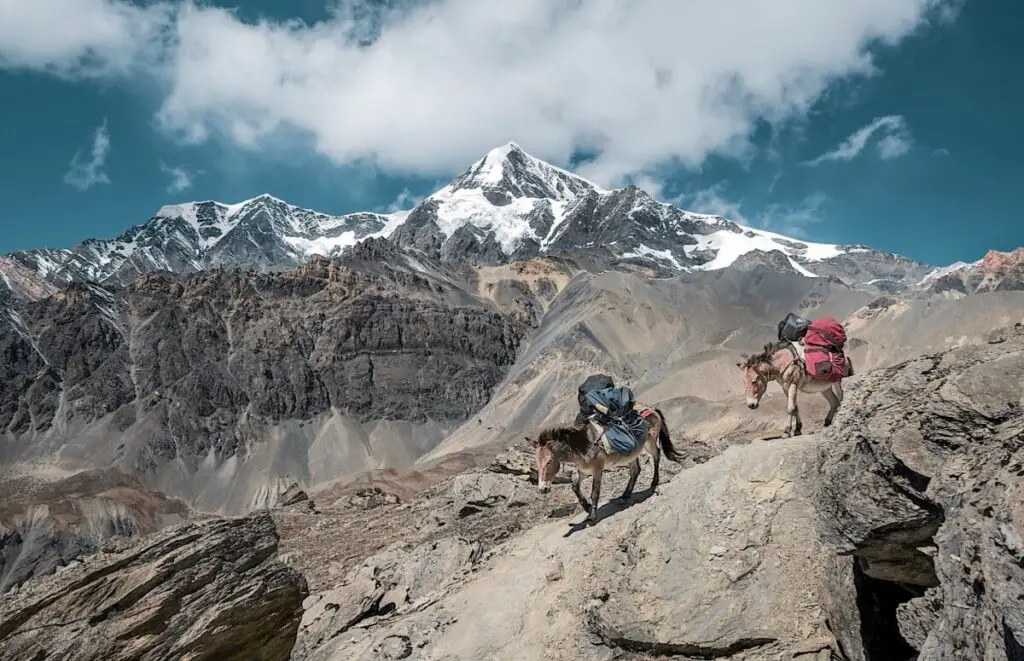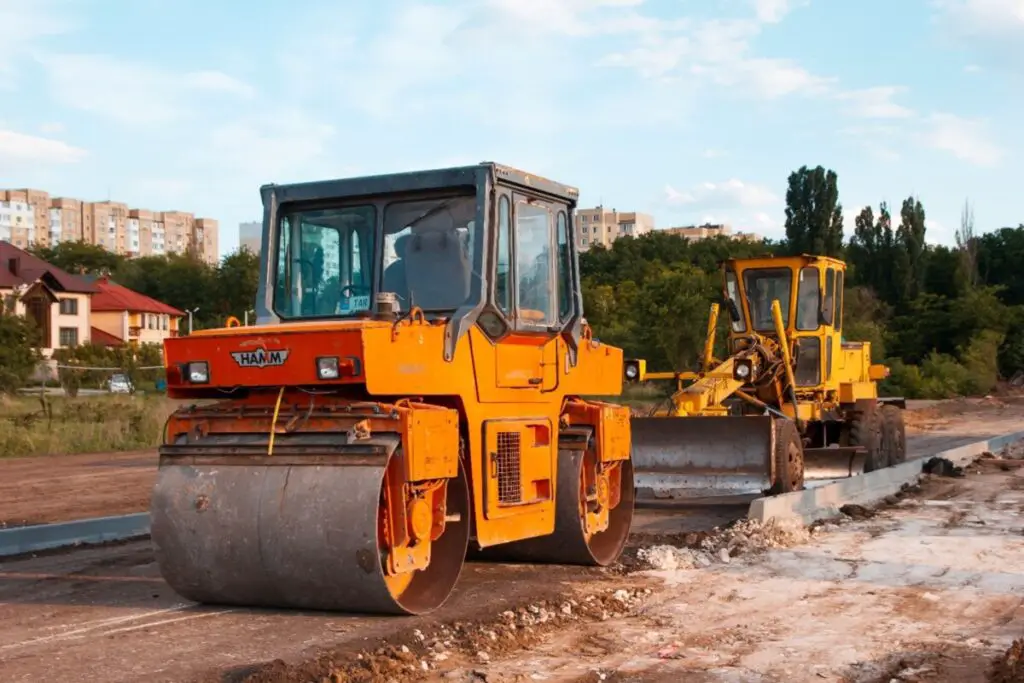|
Getting your Trinity Audio player ready...
|
From dusty trails to smooth asphalt, the evolution of roadways has been a journey through time. From ancient tracks that connected civilisations, to the first paved roads that revolutionised transportation, the history of roadways is a story worth telling.
Imagine a world without roads, where travel is slow and dangerous, and commerce is limited by geography. The history of roadways is one of human ingenuity, perseverance, and the relentless pursuit of progress. It’s a story of how we transformed the world, one paving stone at a time.
Now we are shaping the future with an ever-growing network of highways. So, buckle up and join us on a journey through the history of roadways. Enjoy travelling from ancient tracks to the first paved roads.
Word Stock Photos: A path leading through a forest.
Ancient Roadways and Tracks

From early human nomads treading grassy narrow trails, to larger brained descendants and their superhighways, every culture and society throughout history has developed roads.
Types of Ancient Roadways and their uses.

With the introduction of the wheel, dirt pathways of the ancient world became impractical. As societies grew more complex, so did their road networks. The ancient Sumerians, for example, recognised the need for better infrastructure to support trade and military campaigns. They began building a network of roads as far back as 4000BC. The ancient Egyptians also constructed roads to connect cities along the banks of the Nile River. While the Inca Empire in South America built thousands of miles of roads, many of which still exist.
As loads grew heavier and traffic increased, more durable roads needed to be built. Before the Romans impressed their contemporaries with advanced engineering skills and an extensive network of roads, people constructed roads using a variety of materials and techniques which were unique to each region:
Clay and Gravel
In the Middle East and Egypt, clay and gravel were abundant. And they were often used in conjunction with limestone to create a smoother surface.
Wood
In Europe, which was largely forested, wood was an effective way to raise wheels out of the bogs.
Rock
In China and India, they often chose a more enduring, albeit laborious, approach by carving paths from rock in mountainsides.
Earth Embankments
In pre-Columbian America, they built raised causeways or earthen embankments, then covered them with fine gravel or flat stone.
Photo: Simon Berger/Unsplash. Pack mules going down a mountain
Famous Ancient Tracks, including Roman Roads.
Some ancient tracks have withstood the test of time, most notably the Roman roads. Others have been improved upon over the centuries. Most of these ancient tracks have disappeared, though some parts remain. Here are a few of the most famous ancient tracks:
Old North Trail
In North America, the Old North Trail was used by the Blackfeet Indian tribe. It ran about 3200km (2000 miles) from Canada to Mexico. And it was created for the trading of furs, sacred pilgrimages or cultural exchanges with other tribes. Parts of the track can still be seen in Glacier National Park, Montana.
The Khmer Highway
A network of roads believed to have stretched for 1200-1400km (745-870m) during the 9th to 15th centuries. The Khmer built the highway to connect important trade centres throughout the Khmer Empire in South-East Asia. It covered Cambodia, North-East Thailand, much of Laos, and a large part of Vietnam.
The Persian Royal Road
Built during the Achaemenid Empire in the 5th century BC, the Persian Royal road was an early major road networks. It ran approximately 2,500-2,700 km (1,550-1,680 miles) from Sardi (present day Turkey) to Susa (present day Iran).
The King’s Highway
The King’s Highway goes back to the early Iron Age. It was an important route for commerce between Egypt and Syria in the ancient Middle East. Approximately 1,200-1,300 km, it was used by the Egyptians, the Assyrians, the Babylonians, the Nabataeans, and the Romans.
The Via Egnatia
Via Egnatia was a Roman road that ran 1,120-1,150 km (700-715 miles) from Rome to Constantinople, (modern day Istanbul). Starting in 145 BC it was a continuation of the Appian Way connecting Europe with Asia along the Roman colonies.
The Via Augusta
An ancient Roman road about 1,500 km (932 miles) long from Cadiz in the south of Spain to the Pyrenees in the north. The road was built in the early 1st century AD and was an important trade and travel route for troops and officials throughout the Roman period.
The Via Appia (Appian Way)
One of the early great Roman roads. Begun in 312 BC, it stretched 261 km (156 miles) from Rome to Toranto in the south of Italy in a virtual straight line.
When was the First Paved Road

In the history of roadways, the earliest stone paved roads date back to around 4,000 BC in Ur and 625 BC in Babylon, modern day Iraq, as well as in the Indus Valley, India. The wheeled transport used to transport goods and weapons as their empires expanded created the need for better roads.
The development of metal and stone-cutting tools during the Bronze Age allowed for better and similar-shaped stones. The Minoans on the island of Crete built 50km (31miles) of paved road using sandstone blocks and clay-gypsum mortar. This was then layered with smooth basaltic stones and lined with drains.
Today, the oldest surviving paved road in the world is the 11km (7.5 miles) Lake Moeris Quarry Road in Egypt.
What were Roman roads made of?
The ancient Romans developed paving techniques that have withstood the test of time. However, their techniques depended largely on the geographical location and available materials.
To make their roads, the Romans used several layers of different materials.
Foundation
The foundation layer was made of compressed soil covered with sand.
Crushed Stones
On top of this, a layer of crushed stones was added, followed by a layer of tightly packed, finely crushed stone known as “aggregates.”
Cement
This was then covered by a layer of cement, sand and gravel on which large, interlocking pavement stones were laid.
The method created a durable and long-lasting road that could withstand heavy use and harsh weather conditions. The Romans built their roads in a straight line, which allowed for faster travel and efficient military movement.
Roads in the Middle Ages
During the Middle Ages, while the history of roadways in Europe saw a return of the dirt road, the Arabs in the Middle East built roads covered in petroleum-derived tar. It wasn’t until the Industrial Revolution that progress in the West was stepped up a notch. The development of paving techniques was advanced by:
Pierre-Marie Jerome Tresaguet
The French engineer Pierre-Marie Jerome Tresaguet, who tried applying a scientific approach to the problem of a good, paved road. His technique involved placing a layer of smaller stones on top of larger ones, allowing the movement of traffic to lodge them in place.
Thomas Telford
Thomas Telford from Scotland, who further improved the science of road construction by using cubical stone blocks and paving stones with smaller stones wedged in between. A layer of fine gravel was added on top to create a smoother surface.
John McAdam, and
John McAdam, another Scotsman, who, in the 18th century was determined to find the ideal solution to the troublesome paved road. He proposed that a foundation of earth, instead of stone, could support a layer of angular stones of a specific size. If the top layer of stone was smaller than the width of a wheel, it would provide less stress on the road and hold together better.
Edgar Pernell Hooley
Edgar Pernell Hooley, who in 1901 patented a mixture of coal tar, stone and slag which when pressed using a steamroller, became an effective way to effectively reduce the dust clouds created by fast-moving automobiles.
Advantages of Paving Roadways.
There were many advantages to paving roadways. The most important include:
- It reduced erosion caused by weather and traffic.
- It increased durability – so less maintenance was needed.
- Smooth roads with good traction were safer and caused less damage to vehicles.
- Rainwater drainage was better, so prevented accidents.
- It reduced dust that caused environmental problems.
- It improved transport efficient networks, which boosted economic development.
The History and Evolution of Roadways
Advent of Automobiles Improved Roadways.
While the advent of automobiles improved roadways, we can’t ignore the influence the bicycle had on the demand for better roads as early as the 19th century.
Clubs and societies such as the UK Cyclists’ Touring Club and the League of American Wheelmen, advocated for improved roads which eventually led to the Good Roads Movement in 1891 in the US. New Jersey became the first state to form the State Highway Department, improving the roadways and inspiring other states to follow suit.
Alongside the cyclists, farmers were also instrumental in the development of decent roads. Slogans such as Get the farmer out of the mud were used to draw attention to their plight.
When the automobile became the popular choice of transportation, especially among the rich and privileged who had louder voices and deeper pockets, the demand for improved roadways took on a greater exigency.
Development of Modern Highways and Interstates.
The idea of a national highway system was proposed in 1912 by Carl G. Fisher, a wealthy entrepreneur and founder of the Indianapolis Motor Speedway, USA.
But it was Italy and Germany in the 1920s and 30s that paved the way for the construction of modern expressways and interstate highways. Italy’s first autostrada, which connected Milan and Varese, was completed in 1924. This was followed by Germany’s autobahn system, first conceived during the 1920s and greatly expanded by the Nazis in the 1930s.
It wasn’t until 1956 that the Federal Aid Highway Act was signed into law by President Dwight D. Eisenhower, authorising the construction of a national system of interstate highways. Inspired by the post war autobahns of Germany, his goal was to connect major cities and transport goods and people efficiently and quickly across the US.
Photo: Maria Lupan/Unsplash. Road under construction
Impact of Technology on Road Construction.
Technology has had a significant impact on road construction over the years. There are developments in the use of computer-aided design (CAD) to create highly accurate road designs, leading to better project planning and more precise construction.

Automated equipment such as graders, pavers, and compactors have revolutionised the construction process, leading to faster and more efficient construction.
Another technological advancement in road construction is the use of intelligent transportation systems (ITS), which include various technologies such as traffic monitoring, electronic toll collection, and dynamic message signs. These systems improve traffic flow and safety, reduce congestion, and provide valuable information to motorists.
Future of Roadways and Transportation.
The future of roadways and transportation is likely to be shaped by a combination of new materials, technologies, and innovations in transportation systems. These advancements in construction technologies will lead to increased efficiency, reduced environmental impact, and improved safety on the road.
Some of the innovations include:
- Self-healing concrete that can detect and repair cracks on its own.
- Photovoltaic roads that generate electricity from the sun.
- Smart highways embedded with sensors and LED lights that communicate with autonomous vehicles.
- New materials such as carbon fiber composites for use in road construction.
- Electric vehicles becoming increasingly popular as battery technology improves.
- Autonomous vehicles with the potential to reduce the number of accidents on the road and improve traffic flow.
- High-speed transportation system using magnetic levitation and low-pressure tubes.
Future roadways will no doubt revolutionise long-distance transportation, reduce travel time and increase efficiency.
Photo: Word Stock Photos. Lights on city highway.
Final Thoughts
And so, we reach the end of our journey through the history of roadways. From the humble beginnings of ancient tracks to the sleek and modern highways of today, it’s been a tale of human ingenuity and perseverance. We’ve seen how roadways have connected civilisations, fueled commerce, and transformed the world. They’ve made travel faster, safer, and more efficient, bringing people closer together and enabling us to explore the world like never before.
The history of roadways is a testament to the power of human ambition and the unrelenting pursuit of progress. It’s a reminder that even the most basic of inventions can have a profound impact on our lives, and that the legacy of our innovations will continue to shape the future.
So, let us reflect on the journey we’ve taken, and the road ahead. For the story of roadways is not just about the past, but about the future we’re building, one stone at a time.
FAQs
Q: When were the first paved roads developed?
A: The development of paving techniques and the first recorded instance of a paved road are not specified in the history of roadways. However, paved roads began to appear in the ancient world and have continued to evolve over time.
Q: What was the significance of ancient tracks?
A: Ancient tracks played a crucial role in connecting civilisations and enabling trade and commerce. They also made travel faster and safer, paving the way for further exploration and expansion.
Q: How did the advent of automobiles impact the evolution of roadways?
A: The advent of automobiles created a demand for improved roadways, leading to the development of modern highways and interstates. This, in turn, revolutionised transportation and made travel faster, safer, and more efficient.
Q: What is the future of roadways and transportation?
A: The future of roadways and transportation is shaped by ongoing technological advancements and the continued pursuit of progress. With the development of new materials and construction techniques, the future of roadways promises to be even faster, safer, and more efficient than ever before.

